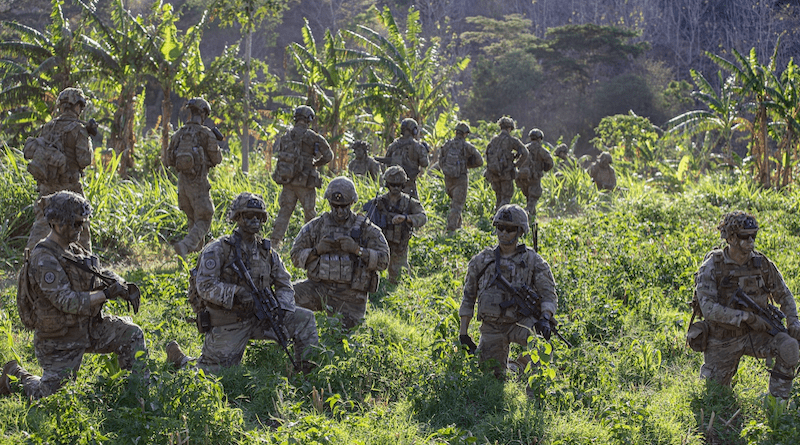US, Partners Hold Super Garuda Shield Military Exercice In Indo-Pacific
By DoD News
By Joseph Clark
Just weeks after completing the largest ever Talisman Sabre in Australia, U.S. and partner forces are back in the field for another large-scale exercise designed to advance a free and open Indo-Pacific.
This year’s Exercise Super Garuda Shield has brought seven participating nations and another 12 observers to Indonesia for a series of joint, multinational drills reflecting what U.S. defense officials say is a growing demand to participate in multinational training events.
This year marks the second iteration of Super Garuda Shield, which evolved out of bilateral Garuda Shield exchanges between the U.S. and Indonesia that began in 2006.
About 2,100 U.S. and 1,900 Indonesian troops make up the bulk of forces in this year’s exchange.
Troops from Australia, Japan, Singapore, France and the United Kingdom are also participating in the two—week exercise, which kicked off August 31. Several countries — Brazil, Brunei, Canada, Germany, India, Malaysia, Netherlands, New Zealand, Papua New Guinea, Philippines, South Korea and Timor Leste — are also present as observers.
The training includes academic exchanges and professional development exercises, in addition to a command and control simulation, amphibious and airborne operations, an airfield seizure exercise, and field training that culminates in a live-fire event.
“It’s an opportunity to continue to develop our warfighting readiness and interoperability,” said Army Maj. Gen. Marcus Evans, commander of the 25th Infantry Division and the U.S. military lead for Super Garuda Shield.
“Everyone sees the value of training in the region,” he said.
Soldiers from the 25th Infantry Division were among the nearly 30,000 troops from 13 nations that participated in Talisman Sabre this year. The exercise included a variety of large-scale logistics and amphibious assault training operations and multinational firepower demonstrations and field training exercises.
The unit has also been employed among the nearly 700 Defense Department personnel mobilized as part of the interagency response to the Maui wildfires.
“Coming off of Talisman Sabre, still being engaged in supporting the efforts in Maui, and then simultaneously executing Super Garuda Shield … I think it really shows the agility of this Army division here in the Pacific,” Evans said.
Evans said regional allies are matching the United States’ buy-in and agility, as evidenced by the expanding scale of the exercises taking place in the Indo-Pacific.
Just weeks after hosting Talisman Sabre, Australia sent a tank and infantry combat team and staff elements to participate in Super Garuda Shield.
Australian forces transported more than a dozen armored vehicles—including M1A1 Abrams tanks and support vehicles—thousands of miles from the southern coast of Australia into Indonesia to participate in the exercise.
After completing the cross-continental transit from the city of Adelaide in southern Australia to Darwin in the north, a U.S. Army vessel ferried the armored vehicles for their final leg into Indonesia.
Australian army Lt. Col. Michael Henderson, commanding officer of the 1st Armored Regiment, said exercising the capability to move troops and equipment throughout the theater immense training value.
“That’s one of the major objectives for us as the Australian Defense Force, just to demonstrate our ability and willingness to project credible combat force up in this region and to be able to do so with partners and allies,” said Henderson, who’s serving as Australian Defense Force contingent commander for Super Garuda Shield.
That agility among regional allies will continue to pay dividends as the U.S. leads like-minded partners.
Talisman Sabre and Super Garuda Shield are among the more than 40 army-to-army and joint exercises led by the U.S. each year as part of Operation Pathways, a collection of multinational exercises throughout the Indo-Pacific and a key pillar of the United States’ integrated deterrence strategy.
And the increased appetite among allies and partners to participate in multinational exercises throughout the Indo—Pacific is a key indicator that the United States’ strategy in the region is paying off.
“This thirst and this behavior that they are exhibiting in the region is they appreciate the ability to come together as a multinational force [and] learn from one another, and they are doing it more and more,” said Gen. Charles A. Flynn, commander of U.S. Army Pacific.
“To me, that is the greatest indicator of the success we are having,” he said.
Flynn added that the exercises are a sign that U.S. allies are “speaking with their actions” in response to China’s aggressive behavior in the region.
Flynn’s remarks during a roundtable discussion at the Hudson Institute in Washington echo optimism expressed by Ely Ratner, assistant secretary of defense for Indo-Pacific security affairs.
“We are delivering on our vision for a free and open Indo-Pacific and absolutely strengthening deterrence in the region,” Ratner said at the Defense News Conference in Arlington, Virginia, last week.
He noted that U.S. military-to-military relations between the Philippines, Australia, New Zealand, Indonesia, Vietnam and the other countries of the Association of Southeast Asian Nations are stronger than they had ever been.”
“The upshot is that we have been engaging in a number of activities with them that have … led to a more distributed mobile, resilient and lethal [U.S.] force posture in the region,” Ratner said.
Both Evans and Henderson said the value of training with partner forces in the region cannot be overstated.
“The more often we’re able to train in environments like this, the more we learn from each other and plan together,” Henderson said. “We skill share, and, really importantly, we build people-to-people links.”
“I think what’s really important is that individuals, right down to the lowest level, get to understand their counterparts,” he said.

